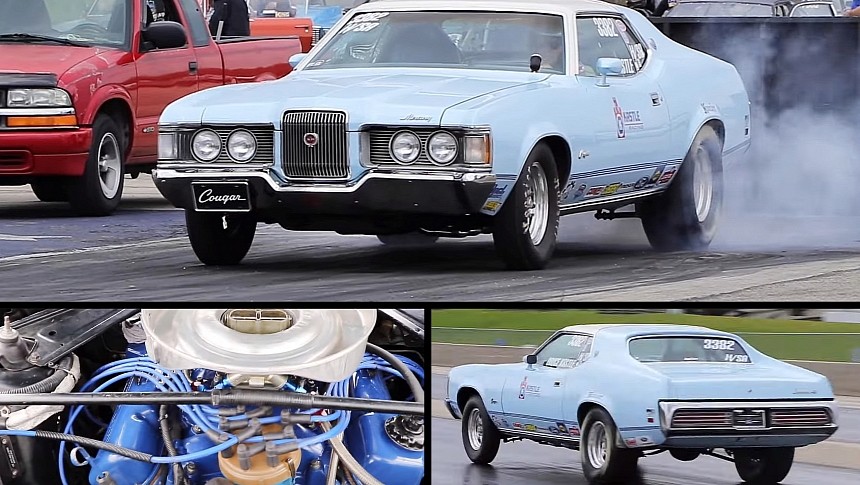The jury is still out on which vehicle kickstarted the muscle car era. Some say it's the Pontiac GTO, while others point out the Chrysler C-300 and Rambler Rebel of the 1950s. I think we can trace everything back to the 1949 Oldsmobile 88. However, I also believe that we owe the muscle car segment to the drag racing wars of the early 1960s.
That's when Detroit automakers were still racing full-size cars down the quarter-mile. I'm talking about iconic rigs like the Pontiac Catalina, Chevrolet Impala, and Ford Galaxie. But stuffing massive engines in full-size cars worked only up to a point. When shaving more weight became an issue, carmakers switched to the then-new midsize cars and ponies.
And because NHRA regulations required a specific number of production models for homologation, Ford, GM, and Chrysler unleashed several drag-ready rigs into showrooms. The list is too extensive for this blurb, but I bet you remember the Ford Thunderbolt, Plymouth Belvedere RO23, and the Chevrolet COPO Camaro ZL-1.
But not all automakers were heavily involved. Mercury, for instance, had only a brief showcase at the drag strip before it began focusing on NASCAR racing. It happened in 1964 when it dropped a Thunderbolt-spec 427-cubic-inch (7.0-liter) V8 in a Comet prepped for the A/FX class. But that's not to say non-experimental Mercury vehicles weren't suitable for drag racing.
Privateers actually raced quite a few Cougars and Cyclones back in the day with impressive results against factory-backed opposition. And as the video below will show you, even a big and heavy second-generation Cougar can become a fantastic quarter-mile runner without radical upgrades.
Built from 1971 to 1973, the second-generation Cougar was still based on the Ford Mustang. Howver, the latter had grown bigger and heavier and the Cougar followed suit. That wasn't an issue with the range-topping 429-cubic-inch (7.0-liter) Super Cobra Jet under the hood, but the second-gen Cougar also came with the smaller 351-cubic-inch (5.8-liter) Windsor and Cleveland mills.
The entry-level 240-horsepower version needed about 16.3 seconds to cover the distance, while the 285-horsepower variant crossed the finish line in 15.4 clicks. For reference, the Super Cobra Jet was tested at 14.3 seconds back in the day. Well, the 1971 Cougar XR-7 you see here is a mostly stock Cleveland version that runs the quarter-mile in less than 12 seconds.
Granted, the mill cranks out more than the factory-specified 285 horsepower, but the engine looks fairly stock. The Cougar is also still using its factory C4 transmission and rear end. Of course, the owner now relies on a cut-off exhaust and drag-spec Hoosier rubber, but that's still mighty impressive.
The footage shows the Cougar completing three runs with the fastest stopping the clock at 11.32 seconds and almost 117 mph (188 kph). That's a full three seconds quicker than a factory Super Cobra Jet. The fact that this Mercury is also an original survivor wearing a rare Pastel Blue finish is the icing on the cake.
And because NHRA regulations required a specific number of production models for homologation, Ford, GM, and Chrysler unleashed several drag-ready rigs into showrooms. The list is too extensive for this blurb, but I bet you remember the Ford Thunderbolt, Plymouth Belvedere RO23, and the Chevrolet COPO Camaro ZL-1.
But not all automakers were heavily involved. Mercury, for instance, had only a brief showcase at the drag strip before it began focusing on NASCAR racing. It happened in 1964 when it dropped a Thunderbolt-spec 427-cubic-inch (7.0-liter) V8 in a Comet prepped for the A/FX class. But that's not to say non-experimental Mercury vehicles weren't suitable for drag racing.
Privateers actually raced quite a few Cougars and Cyclones back in the day with impressive results against factory-backed opposition. And as the video below will show you, even a big and heavy second-generation Cougar can become a fantastic quarter-mile runner without radical upgrades.
Built from 1971 to 1973, the second-generation Cougar was still based on the Ford Mustang. Howver, the latter had grown bigger and heavier and the Cougar followed suit. That wasn't an issue with the range-topping 429-cubic-inch (7.0-liter) Super Cobra Jet under the hood, but the second-gen Cougar also came with the smaller 351-cubic-inch (5.8-liter) Windsor and Cleveland mills.
The entry-level 240-horsepower version needed about 16.3 seconds to cover the distance, while the 285-horsepower variant crossed the finish line in 15.4 clicks. For reference, the Super Cobra Jet was tested at 14.3 seconds back in the day. Well, the 1971 Cougar XR-7 you see here is a mostly stock Cleveland version that runs the quarter-mile in less than 12 seconds.
Granted, the mill cranks out more than the factory-specified 285 horsepower, but the engine looks fairly stock. The Cougar is also still using its factory C4 transmission and rear end. Of course, the owner now relies on a cut-off exhaust and drag-spec Hoosier rubber, but that's still mighty impressive.
The footage shows the Cougar completing three runs with the fastest stopping the clock at 11.32 seconds and almost 117 mph (188 kph). That's a full three seconds quicker than a factory Super Cobra Jet. The fact that this Mercury is also an original survivor wearing a rare Pastel Blue finish is the icing on the cake.









